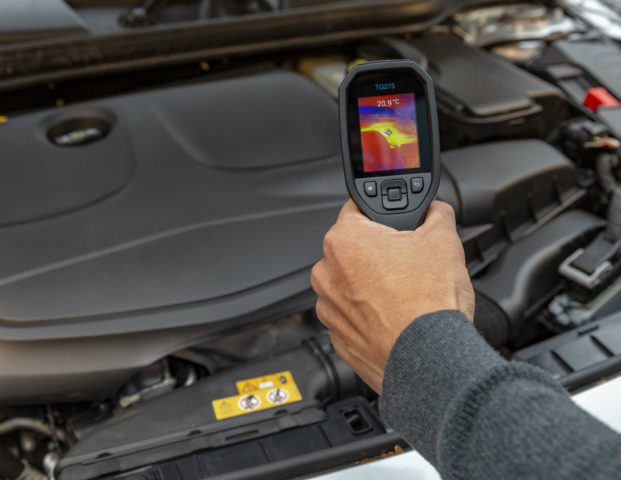FLIR Systems, Inc. has announced a handheld diagnostic thermal camera for auto enthusiasts and professionals, the FLIR TG275.
FLIR also unveiled a thermal imaging camera for the automotive industry, its next-generation thermal vision Automotive Development Kit (ADK) for the development of self-driving cars. It also introduced a thermal enhanced self-driving test vehicle that demonstrates how thermal cameras improve the safety of advanced driver-assistance systems (ADAS) and fill performance gaps in the autonomous vehicles (AV) of tomorrow.
The new cameras and the FLIR thermal autonomous test vehicle are being demonstrated at the 2019 Consumer Electronics Show (CES) at the Las Vegas Convention Center, South Hall Three, booth #31166.
FLIR TG275
The TG275 is FLIR’s first dedicated thermal camera for automotive technicians and home mechanics. In automobile repair, heat can often mean a potential issue, and the TG275 helps technicians spot problems before they lead to failures, and ultimately a roadside breakdown. Equipped with the FLIR Lepton thermal microcamera, FLIR’s patented MSX technology extracts high-contrast details from the images taken by an onboard visible light camera and superimposes them onto the thermal images. Also, the TG275 allows auto repair technicians to reduce diagnostic time and show customers evidence of the problem through before and after images of potential issues.
The TG275 will be available this spring. For additional information, visit www.flir.com/tg275.
Next-Generation FLIR ADK
The next-generation thermal-vision ADK featuring the high-resolution FLIR Boson® thermal camera core is designed to help automakers, tier-one automotive suppliers, and automotive innovators improve the safety of ADAS and self-driving vehicles. Paired with machine-learning algorithms for object classification, the ADK provides critical data from the far infrared portion of the electromagnetic spectrum to improve the decision making of AVs in common environments where other sensors experience challenges, such as darkness, shadows, sun glare, fog, smoke, or haze. The thermal-vision ADK augments the entire sensor suite and offers the redundancy needed to improve safety in AVs.
The new ADK is IP67 rated and now includes an integrated heated window for improved performance in all-weather testing. It also features Gigabit Multimedia Serial Link (GMSL), USB, and Ethernet connection for easier integration. The FLIR ADK is available for purchase at www.flir.com/adk.
FLIR’s Autonomous Test Vehicle
FLIR is also showing the industry’s first thermal camera-equipped commercial test vehicle featuring multiple FLIR ADK cameras that will provide a 360-degree street view. The car demonstrates the ADK’s integration capabilities with radar, LIDAR, and visible cameras found on autonomous test vehicles today. With thermal camera-enhanced automatic emergency braking (AEB), the car helps validate how thermal imaging with machine learning classification improves the functionality of AEB.
“For automated decision making on the roadway, thermal imaging cameras coupled with machine-learning capabilities provide the most effective method for pedestrian detection to save lives, particularly in cluttered environments or in poor visibility,” said Jim Cannon, President and CEO at FLIR. “Furthermore, the FLIR thermal-enhanced autonomous test vehicle demonstrates how thermal cameras can significantly improve urban, highway, and AEB performance and the overall safety of self-driving cars.”
Autonomous car developers interested in more information on the thermal-enhanced test vehicle may visit www.flir.com/adas.
For more information, please visit www.flir.com and follow @flir.


0 Comments